
Christian Hundley

Audio By Carbonatix
“I think my whole existence is very political, in a way,” says Danielle SeeWalker, “because we weren’t supposed to be here.”
SeeWalker, a HúÅ‹kpapÈŸa LakÈŸóta and a citizen of the Standing Rock Sioux tribe in North Dakota, is sitting in a chair in the corner of her Denver studio, just below a portrait that her father painted of her when she was young. The young Danielle has an infectious grin, her hands propping up her head over a background of warm yellow.
SeeWalker will have to move her studio in the coming months; it’s located inside the Evans School in the Golden Triangle, which will be redeveloped. But for now, it is filled with her multimedia works, whose motifs reference her heritage and Native history, as well as personal and historical photos that inspire her. A buffalo hide covers the floor, and her tribe’s flag is tacked to one wall, hanging above another that represents the Land Back movement. A neon-pink sign reads “Mitakuye Oyasin,” a LakÈŸóta saying that loosely translates to “We are all related.”
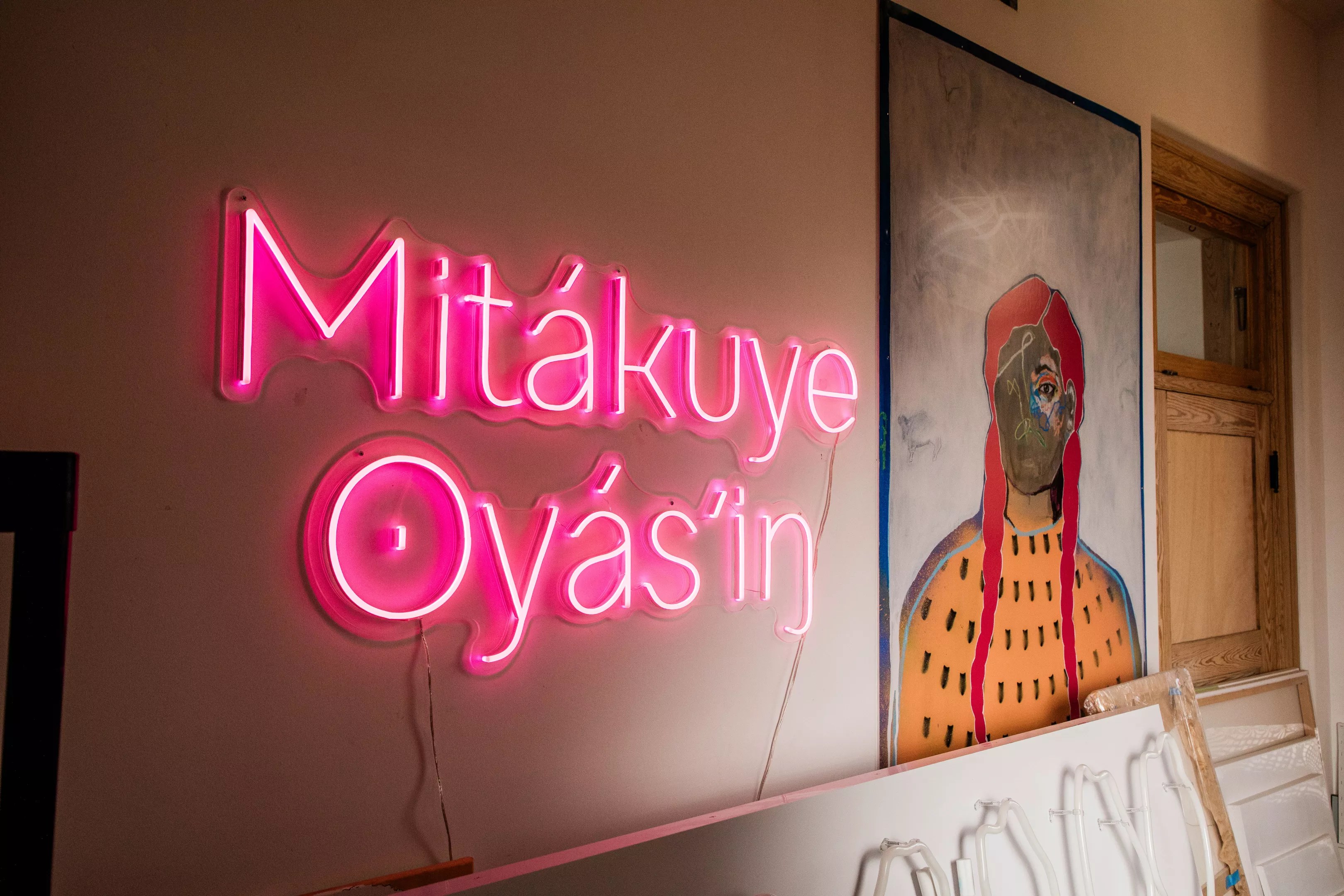
“Mitakuye Oyasin” translates to “We are all related.”
Christian Hundley
Denver, make your New Year’s Resolution Count!
We’re $17,500 away from our End-of-Year campaign goal, with just a five days left! We’re ready to deliver — but we need the resources to do it right. If Westword matters to you, please contribute today to help us expand our current events coverage when it’s needed most.
Most of her artwork comprises portraits of Native people whose faces are bare except for one detailed eye. And in that small portion of the painting, a weighty story is clarified in glances of hope, trauma, suspicion, gentleness. The series came from a dream that, in its telling, sounds more like a premonition. A woman with one eye came to her, SeeWalker remembers. She was clothed in an elk-tooth dress, and cascades of long, white hair floated around her.
“In the dream, she kept following me really closely, and I knew she was from a different time,” the artist says. “When I would look at her, her face was sort of a blur…except for this one eye. It was almost like she was trying to speak to me through just looking at each other.”
The dream lingered with the artist long after she woke up. And SeeWalker soon uncovered the woman’s message.
“I believe it to be speaking up through my art,” SeeWalker says. “You need to tell our stories. You need to speak up. You need to bring narratives from an Indigenous perspective and put it out there. Because you don’t often hear those sides of the narrative of history.”
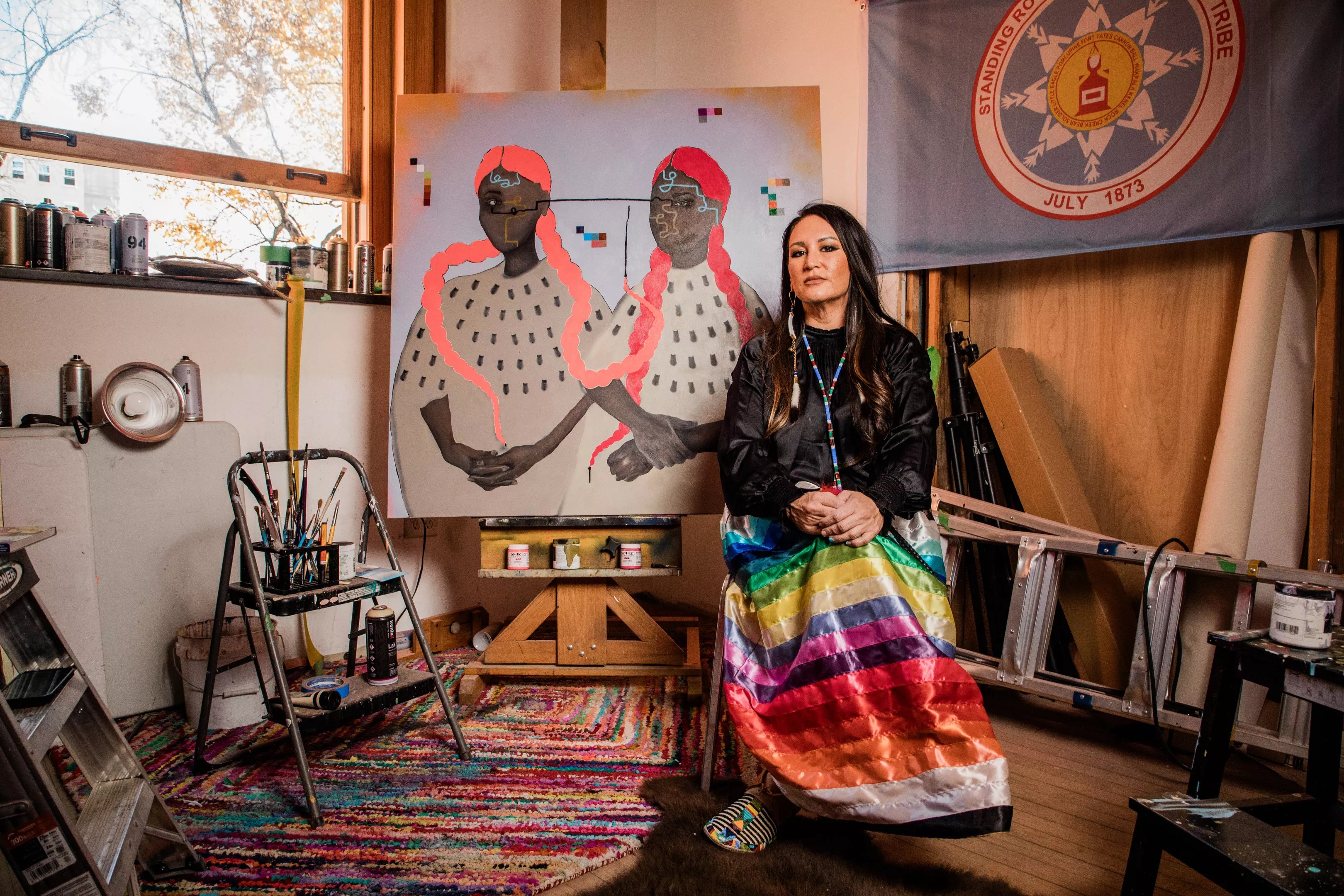
SeeWalker next to her newest painting, which will be shipped off to a show in Philadelphia.
Christian Hundley
SeeWalker’s art proudly emphasizes her people’s history, but this pride goes beyond the canvas, from art to activism. “To me, there’s not a fine or hard line drawn between the two,” she says.
In this year alone, History Colorado has highlighted SeeWalker’s work in a major exhibit; she’s painted murals for the ChromaFest Mural Festival in St. Paul, Minnesota, as well as the Denver Walls festival and Colfax Canvas. She’s just returned from painting with Babe Walls in Atlanta and is getting ready for an upcoming show in Philadelphia. She’s done all of this while working a full-time job at Michelin, managing its accounts with federal entities ranging from the FBI and CIA to the National Park Service, U.S. Border Patrol and the U.S. Postal Service. Somehow, it hasn’t gotten in the way of her productivity.
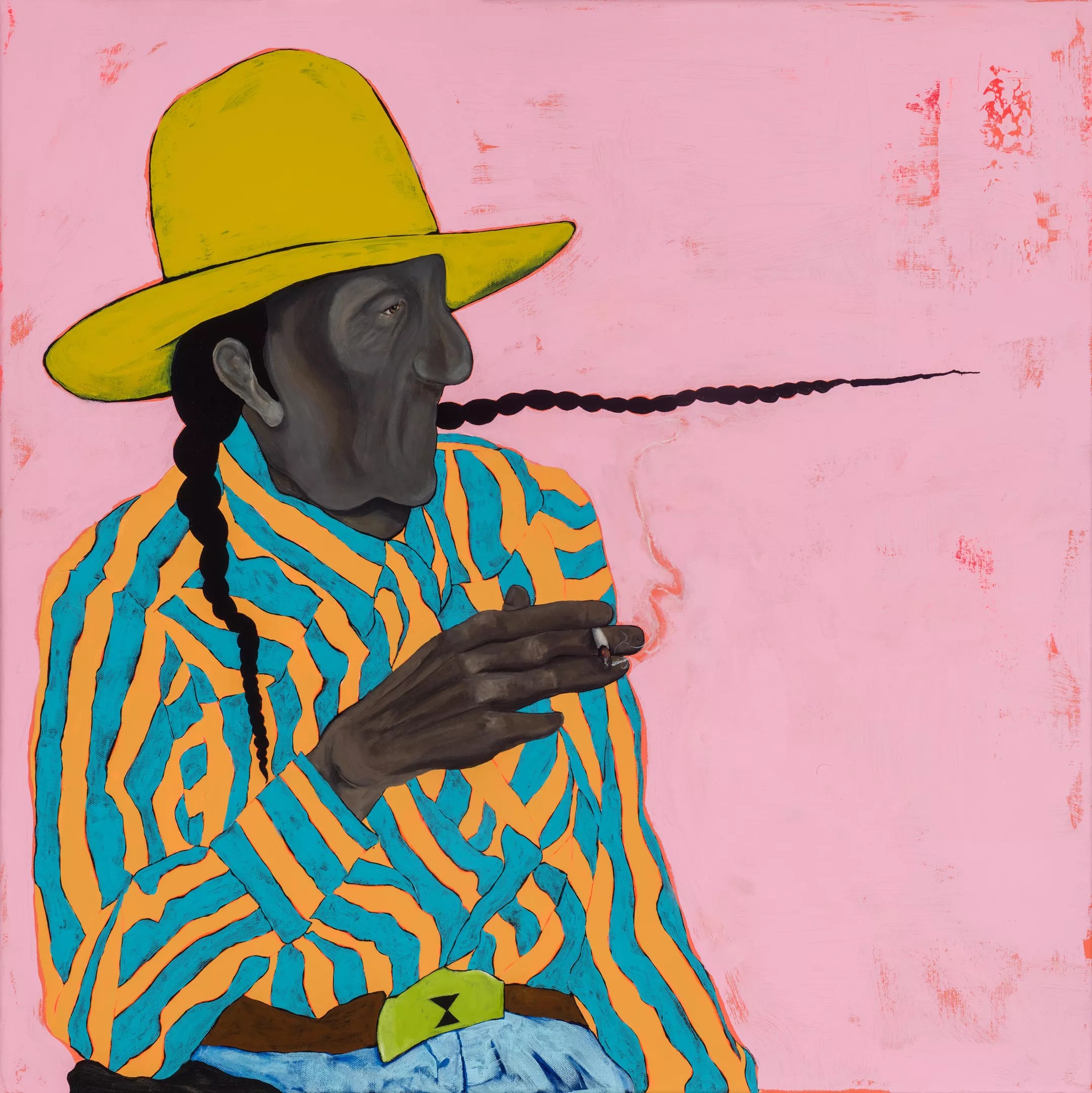
“Uncle Giving Directions” by Danielle SeeWalker.
Danielle SeeWalker
SeeWalker’s most recent project in the art world involved curating an exhibit of Indigenous artists’ work titled This Is Native Art, on display through February at the Colorado Capitol. “This is a historical show,” she notes. “This has never been done before, an all-Native art exhibition in the Capitol.”
Usually, when SeeWalker is in that building, she’s fighting for Native American rights. One of the first bills she helped push banned the use of derogatory American Indian mascots at schools ranging from the elementary to the university level; it was signed into law in 2021. SeeWalker and other Indigenous women worked alongside legislators for years to establish the Office of Missing and Murdered Indigenous Relatives, which also created a missing-persons alert program at the Colorado Bureau of Investigation in 2022.

“You Have My Heart” by Danielle SeeWalker.
Danielle SeeWalker
SeeWalker moved to the Mile High City because of her job. She’s worked for Michelin since 2011 and was based in Illinois and South Carolina before coming to Denver. “It allowed me to be back closer to home and had the qualities of life that were important to me – access to some of the best outdoors, a large Native American community that I could be involved in…and a more liberal community in general where I could raise my kids comfortably,” she says.
“When I moved to Colorado in 2018, there were two main objectives I wanted to do when I was here: get integrated back into the Native community, because I knew there was such a great community of Native people here, and I wanted to immerse myself in the art community,” SeeWalker recalls. “And I did those immediately.”
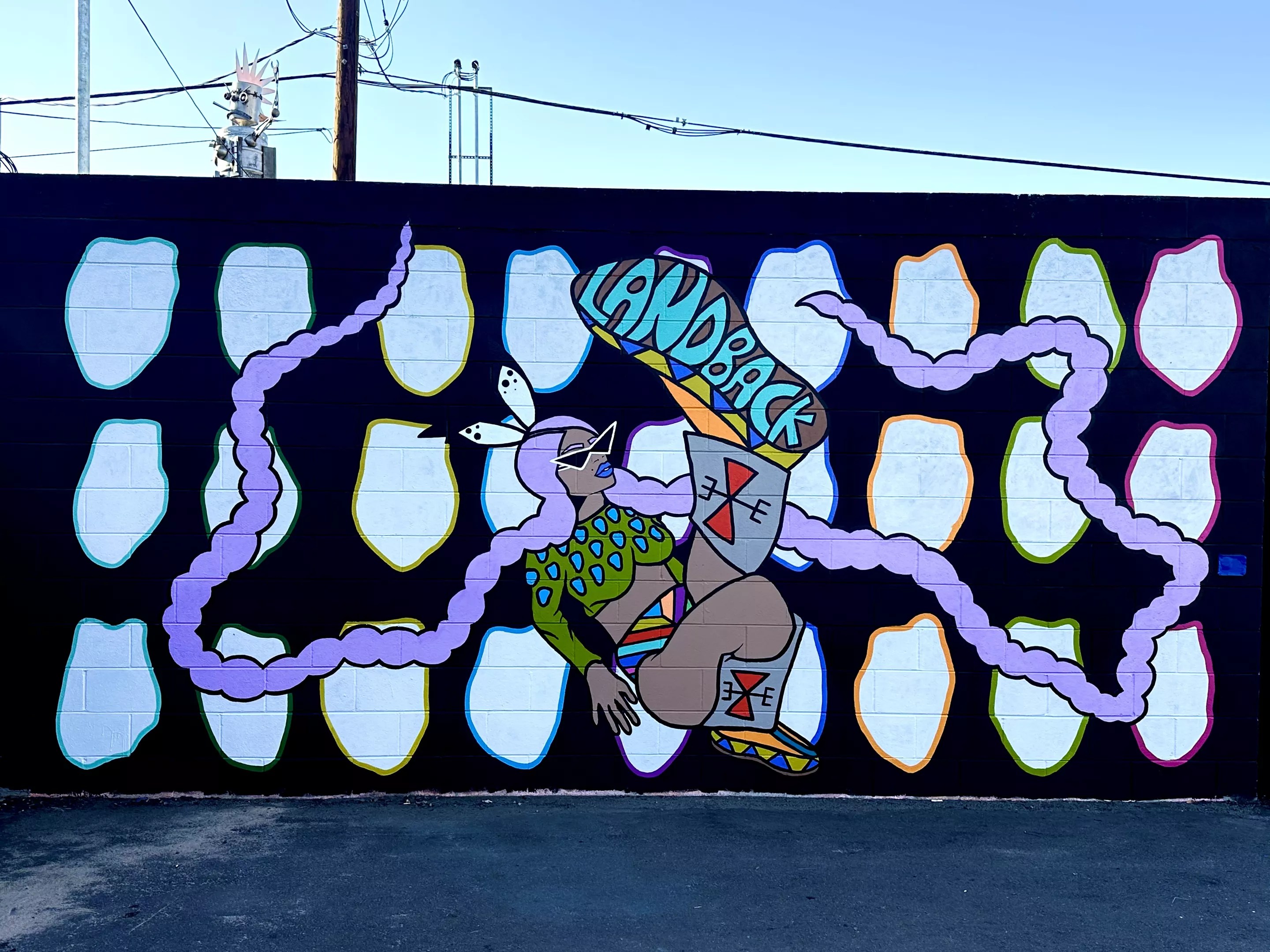
Danielle SeeWalker’s mural “LandBack.”
Danielle SeeWalker
She credits Babe Walls, for which she is now an organizer, with kick-starting her art career in 2020, when the all-women and nonbinary mural festival approached her to participate. SeeWalker hadn’t created a mural before, but she jumped at the opportunity. She and local artist Romelle painted an entire residence in Westminster with a mural highlighting Native women and drawing attention to the missing and murdered Indigenous relatives crisis that she would spotlight at the Capitol for the next two years.
Her art career quickly picked up, moving beyond Colorado and even this country. SeeWalker was in Amsterdam last year to install a mural celebrating street art and graffiti for the STRAAT Museum. Next May, she will go to Gaza, where she plans to contribute a mural on the West Bank. The Palestinian Artists Consortium reached out to her this spring to contribute to an online symposium held in June, not long after it learned of an incident involving SeeWalker that made headlines around the world.

“G Is for Genocide” was the reason SeeWalker’s Vail residency was canceled.
Danielle SeeWalker
In May, the Town of Vail removed SeeWalker from its Art in Public Places residency program because of a mixed-media piece she’d created months earlier relating the tragedies of American Indians and Palestinians, titled “G Is for Genocide.” Represented by the ACLU, SeeWalker filed a civil complaint against Vail in October, on Indigenous Peoples Day.
She admits she’s somewhat nervous about installing a mural on the West Bank, but art as a means of resistance is in SeeWalker’s blood. “If there’s an opportunity for me to collab with a Palestinian muralist there and work together to create a piece in solidarity, I would love to do that,” she says.
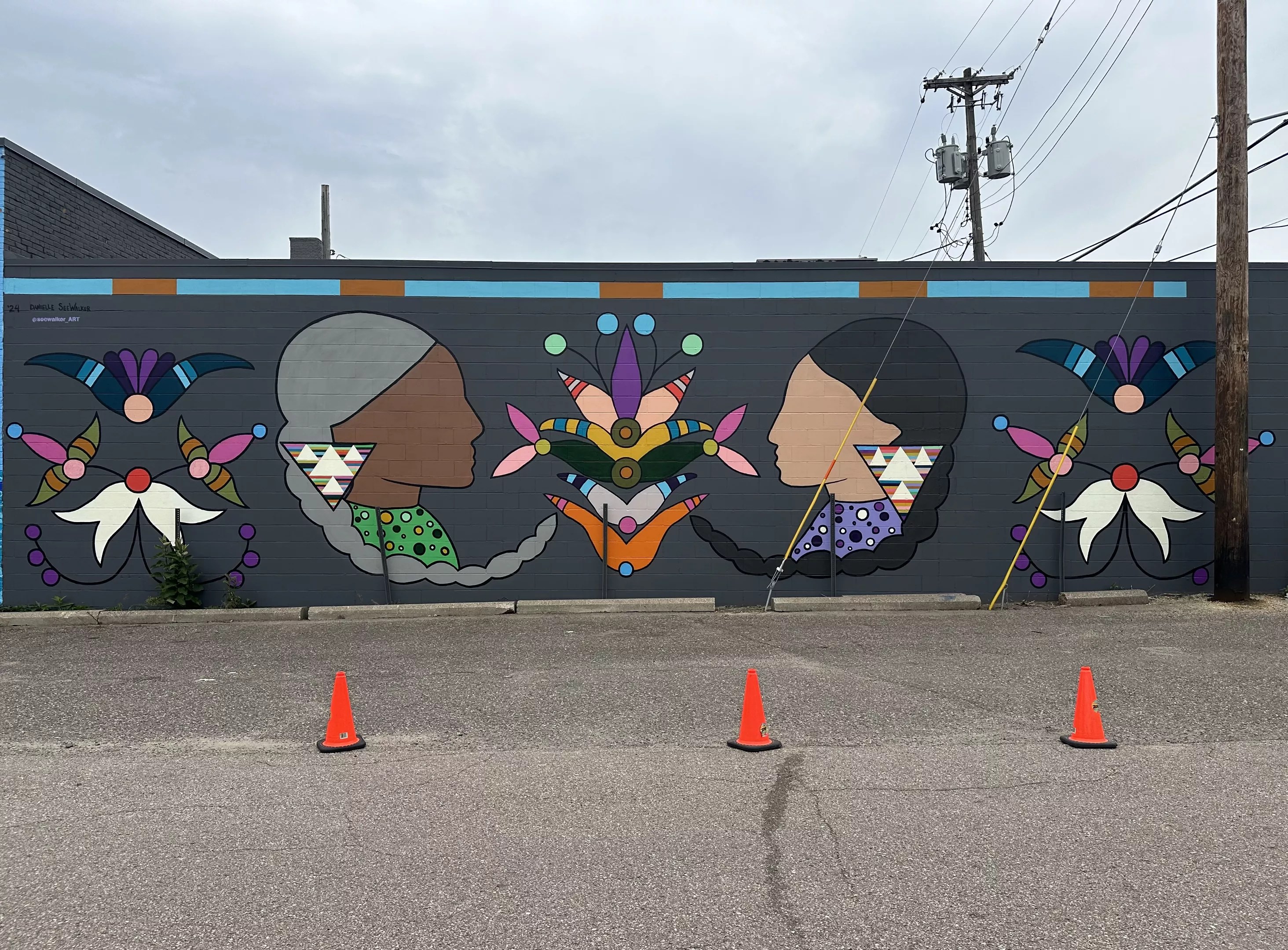
“Dakota Ancestors” by Danielle SeeWalker.
Danielle SeeWalker
She’s also working on the Red Road Project, which she started with her best friend, Carlotta Cardana; their first show was in Italy in 2013. “It’s all about documenting Native people as we exist today, a photo-documentary project,” SeeWalker says. “We’ve had exhibitions all over the world for that. My best friend does all the photos, and I do the writing for it. Currently, it’s on tour for four years; that started in Walnut Creek outside of San Francisco, which was one of our biggest U.S. shows so far.”
The two artists founded the Red Road Project after SeeWalker became increasingly frustrated with the media’s depictions of Native life. “Why are they not reporting on the language revitalization, or the amazing artwork that’s being done and put out there by these people? Or the rich beauty, the culture and all the great things that are happening in Indian Country?” she says. “Those stories never get told. And I was talking to my best friend about it, and she’s like, ‘Well, why don’t we tell those stories?’ And that resonated with me. Something my dad always told me was, ‘If you don’t speak up, Danielle, nobody’s gonna do it for you.'”
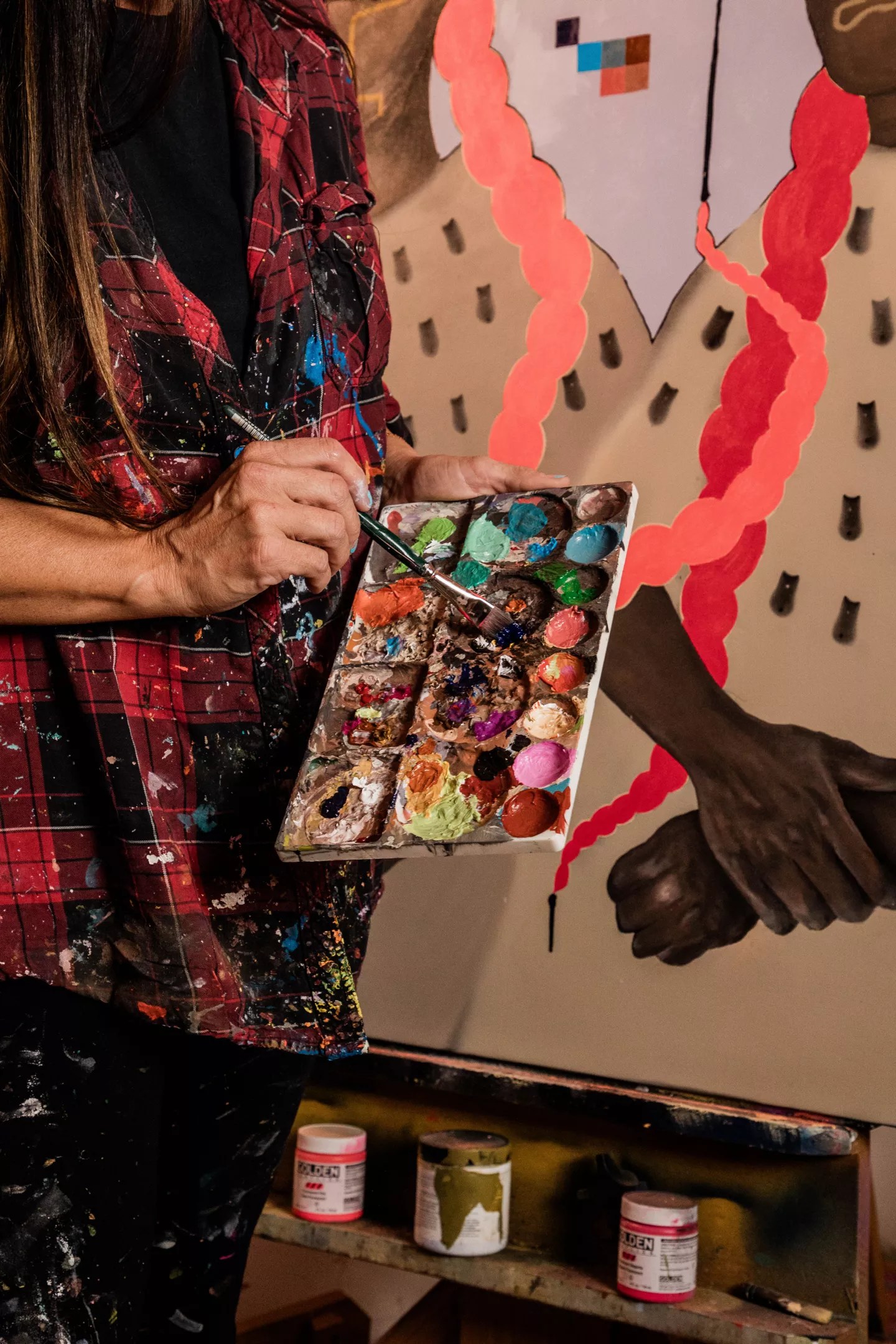
SeeWalker puts finishing touches on her latest painting.
Christian Hundley
Her artistry comes from her dad’s side, SeeWalker says, adding that her aunts and uncles are also talented, self-taught artists. For her own art, she has developed a distinct approach to her subject matter that brings to mind the expressionistic, multimedia work of such artists as Deborah Roberts, but with a style unique to SeeWalker.
Based on her dream, SeeWalker’s current series of mixed-media works include bright as well as muted colors creating portraits of Native people, with line designs placed around the singular eyes and dots along the clothing that portray elk teeth stitched in traditional dresses.

“Everyone talks about having a seat, but this table ain’t for us” by Danielle SeeWalker.
Danielle SeeWalker
In her latest painting, “Everyone talks about having a seat but this table ain’t for us,” two women in elk-tooth dresses, their hot-pink hair braided, stand close to each other, arms tensely crossed over their bodies. One woman’s eye looks to her friend, as if asking whether she is thinking the same thing, while the other’s eye is fixed forward with a steely gaze.
“I’m constantly looking through old images of people from my tribe,” SeeWalker says, “just studying it and thinking, ‘What are they wearing? What’s their facial expression? I wonder what they were thinking or going through in that moment.'”
In another work, the eyes of two children show fear over “what they were seeing and experiencing during the colonization, or if they were about to be taken away to go to boarding school,” SeeWalker says. “The eyes set the tone of what is going on in the piece.”
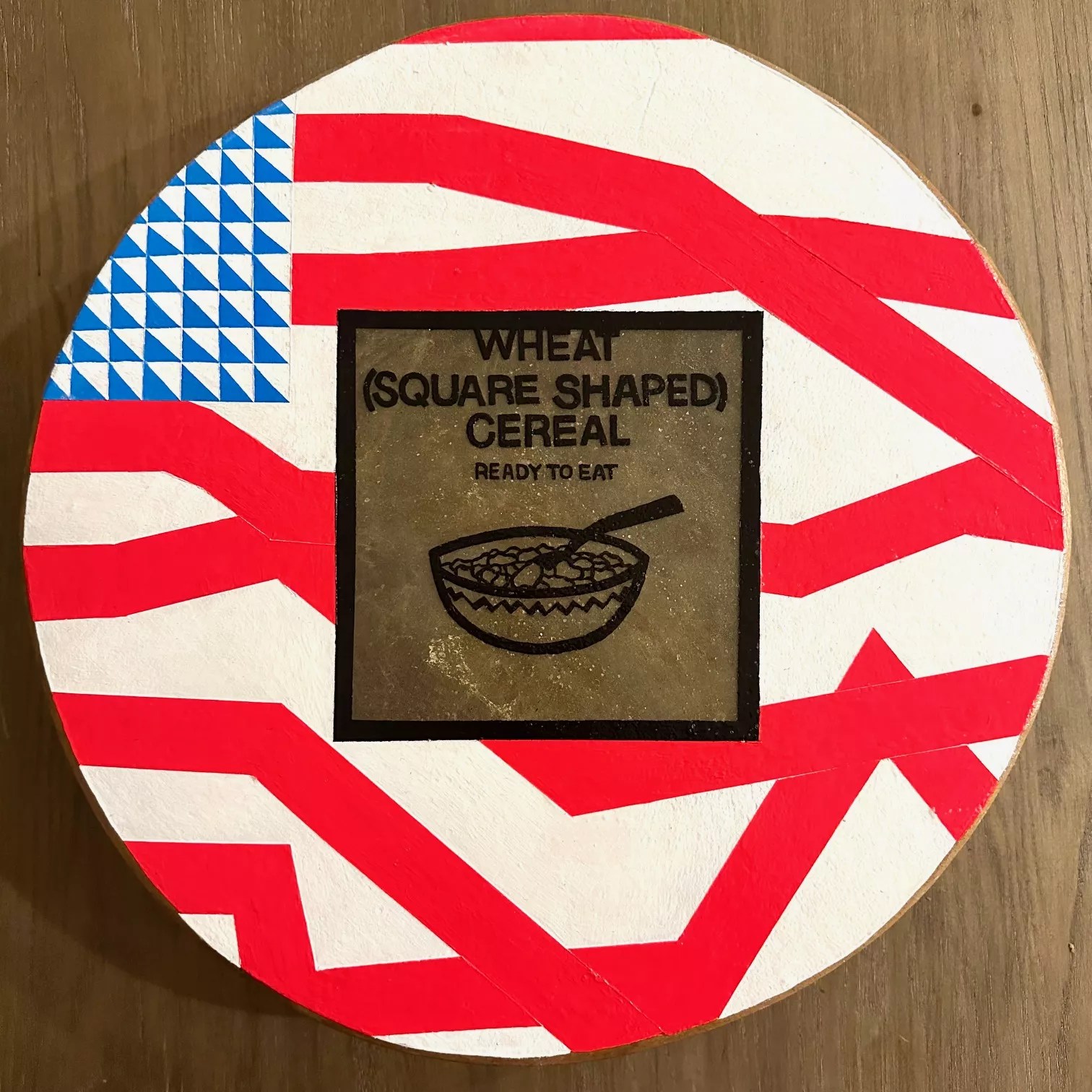
SeeWalker showed her painted drums in the History Colorado exhibit.
Danielle SeeWalker
For her exhibit at History Colorado, the museum invited SeeWalker to look through its archives to find pieces that might inspire and link to her work. For some mixed-media works, she referenced historic photos of tribes lining up for food from the Food Commodity Program run by the federal government. While tribes at the turn of the century were used to relying on traditions such as hunting, now they were eating what they were given, including canned meat and dried eggs. SeeWalker decorated drums with colorful symbols surrounding the labels on such provisions – “Pork with juices” above the silhouette of a pig, “Wheat (square shaped) cereal – Ready to eat” above an illustration of a cereal bowl.
“I remember growing up having to eat this. I’ll never forget the canned meat,” she says. Because tribes had only eaten dried, hunted meat and other fresh food, before, the canned food had a negative impact on the people’s health. “The foods that they gave us – flour, large amounts of sugar, dairy – were things that we had never been exposed to, and this was only a few generations ago. So to this day, we Native people have the highest rate of diabetes in the country. There’s probably not a Native person I know that isn’t lactose-intolerant.”
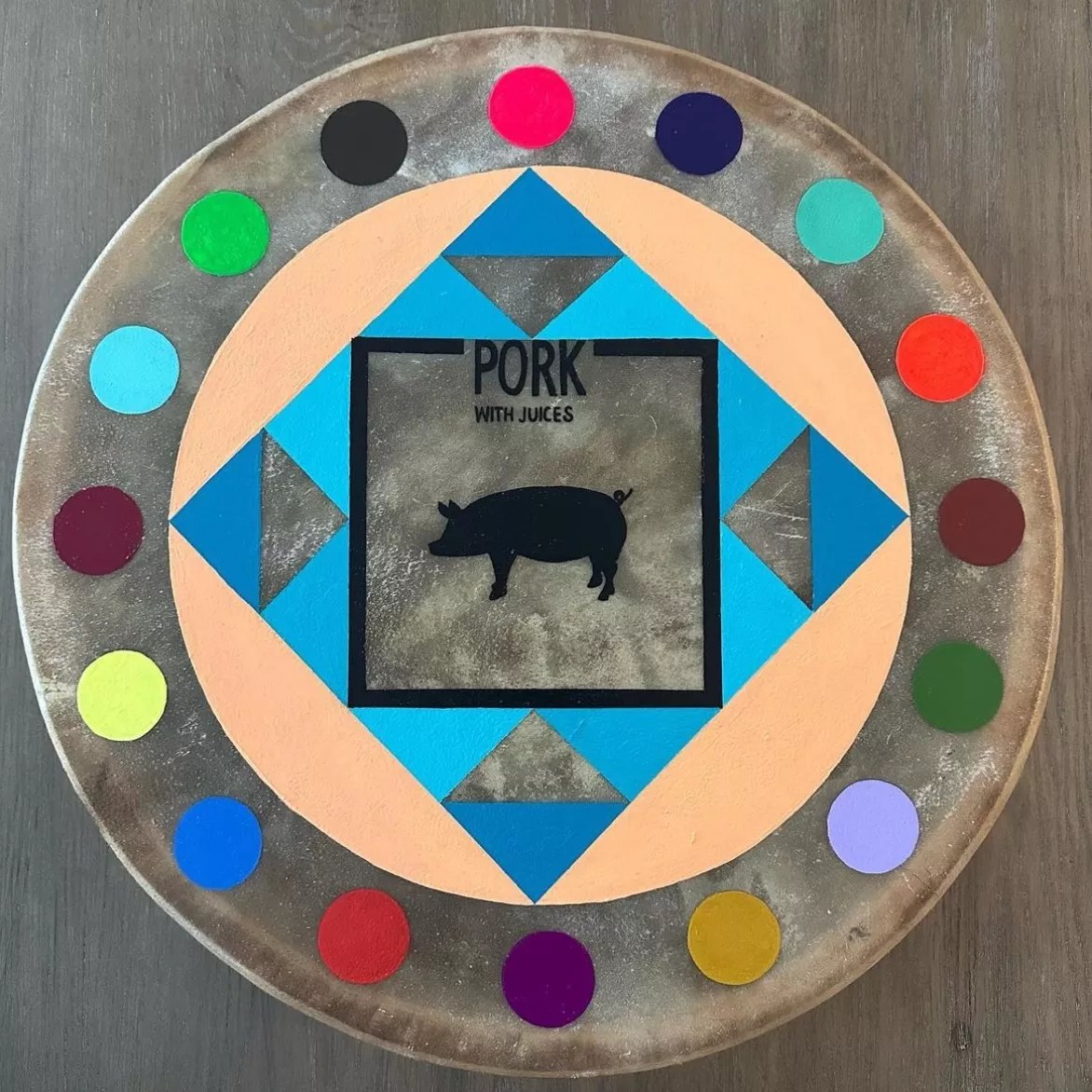
A painted drum shows the label of canned food from a government program.
Danielle SeeWalker
Much of what she saw from the museum’s inventory gave her mixed feelings. “I remember thinking, ‘Some of these are sacred objects that should be given back,’ or seeing some pieces that were misidentified,” she says, recalling a hair piece that was labeled as a belt. She pointed that out to the museum, and then used it in her show.
Still, “to be the first Native woman to show my artwork in that institution is a good accomplishment in terms of resistance,” she notes. “If my grandmother were still alive, she would be in disbelief that there’s, like, a woman in the Cabinet that’s Native, or that we have people who are Native in office. I don’t know that she would ever believe that her granddaughter would be able to show in a museum and to talk about these topics out loud.”
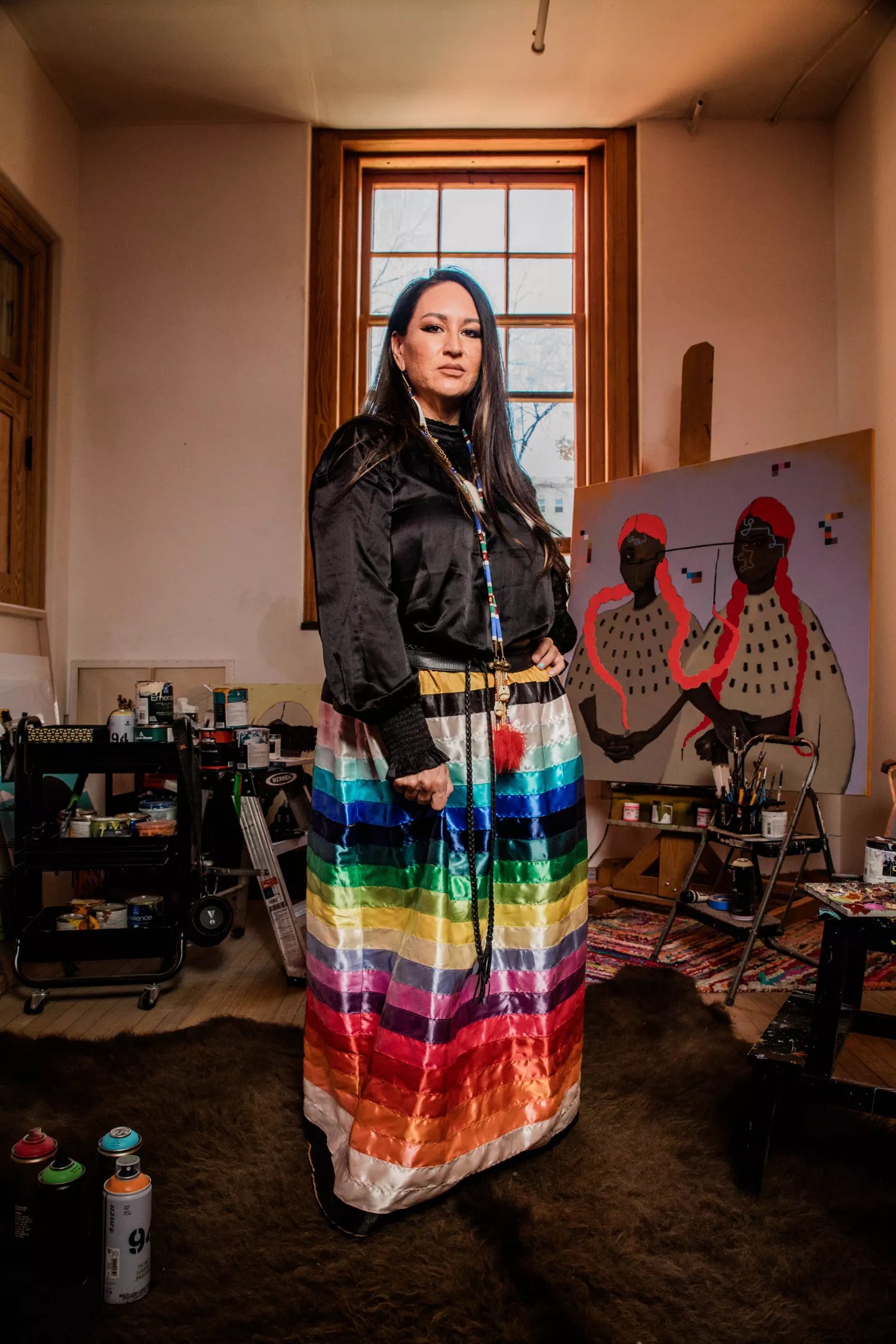
Christian Hundley
Her grandmother had been sent to boarding school, and would only speak her native language with friends; she would not teach it to her children or grandchildren. “When she went to boarding school…if you spoke your native language, you were beaten,” SeeWalker says. “She never wanted to speak about her experience there; she and her brother were orphaned in those schools, so they didn’t know anything outside of being in a boarding school. That’s where the pivotal turn was in my family, of losing our language, losing a lot of our cultural aspects, because she grew up in these boarding schools. … When she went back to the reservation, I’m sure she felt, ‘I’m not Indian enough, but I’m also not white enough.’ So there was this struggle.”
SeeWalker can empathize with that. There was a time she pushed back against expressing her heritage because of the bullying she endured in a predominantly white school. Her Native father was only educated through eighth grade and “was a very huge proponent of education,” she says. She split her time between the reservation and school in Bismarck, about ninety minutes away.
“My parents wanted me to go to school in Bismarck because the education on reservations isn’t always the best, I guess,” she explains. “I always had to wear my long braids, and that was just a very big target. I remember people would say, like, ‘Oh, your parents are probably drunks,’ stuff like that. How would a ten-year-old know that unless their parents are reflecting that on them?”
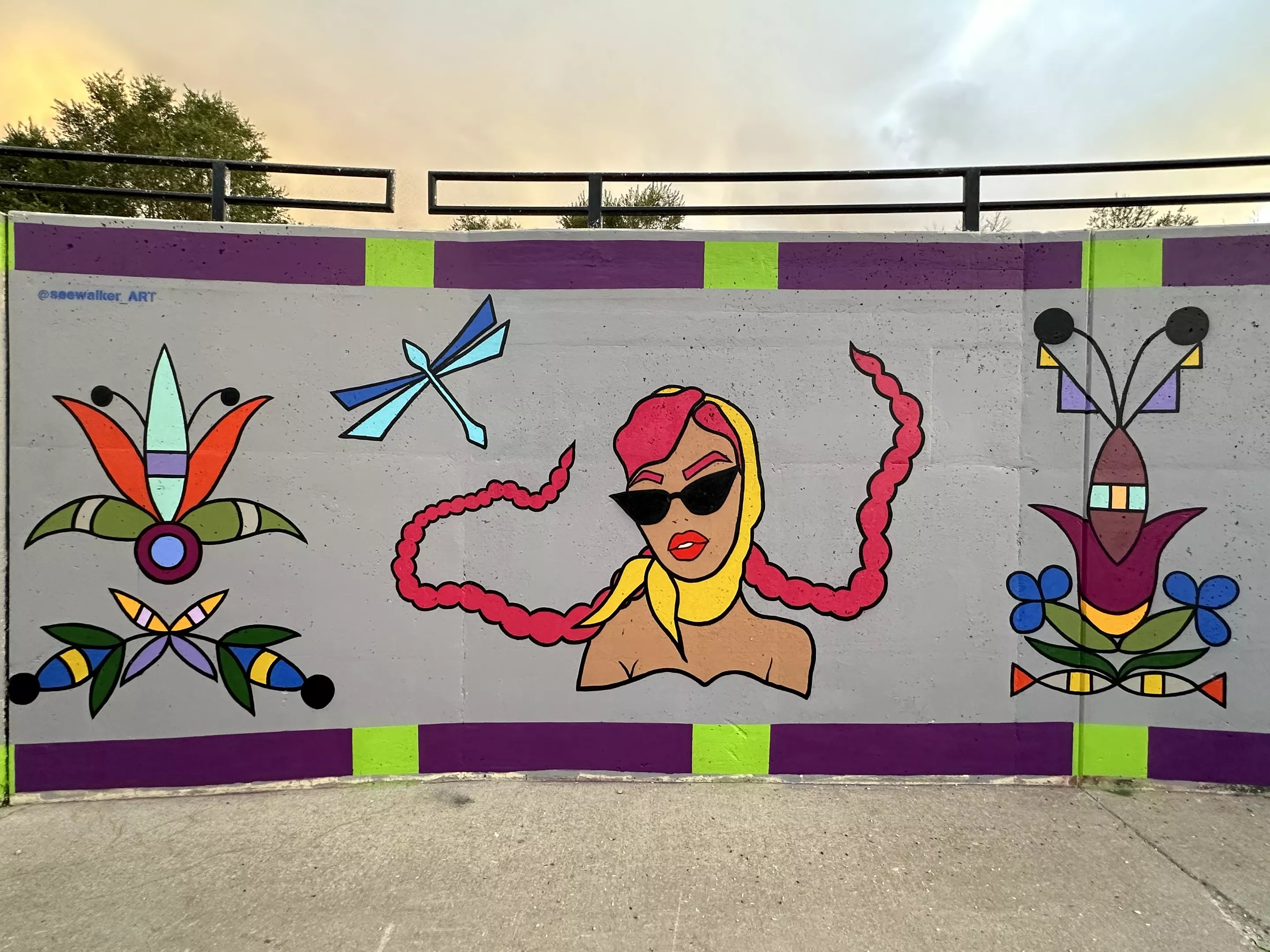
A portion of SeeWalker’s mural, “The Aunties.”
Danielle SeeWalker
While her father, who passed away in 2014, always reinforced pride in her culture, the bullying still caused SeeWalker to become “traumatized with my identity,” she says. “I was feeling ashamed with who I was.”
During her senior year of high school, she and her mother moved to Pennsylvania, and SeeWalker decided to attend college in that state. When she moved outside Philadelphia to study at Albright College, she cut her hair and bleached it blond. “I was wearing makeup a shade lighter,” she recalls. “I wanted to not be identified as Native in any way.”
She says that this “identity crisis” lasted until her mid-twenties. It didn’t help that there weren’t many Native people on the East Coast, despite those people who might say they were one-sixteenth Indigenous – “and it’s always Cherokee,” SeeWalker laughs. But through studying anthropology and sociology after moving to Kutztown University, as well as having “deeper conversations about identity and culture” with her professors, SeeWalker embraced her heritage. She graduated in 2010.
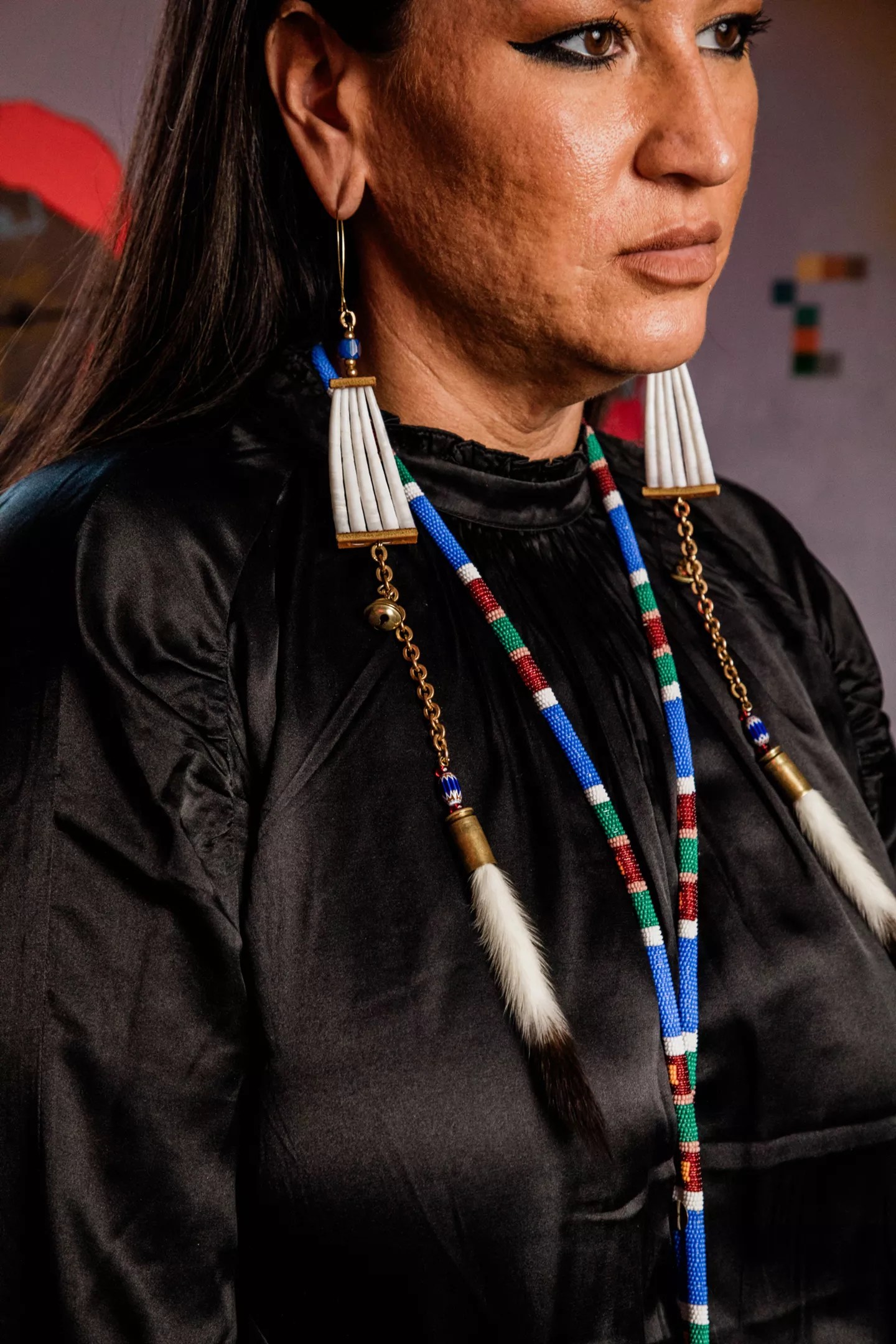
SeeWalker is Húŋkpapȟa Lakȟóta and a citizen of the Standing Rock Sioux tribe in North Dakota.
Christian Hundley
Since then, her art has become a method of healing. Through the Red Road Project, she’s heard other Native people tell stories similar to hers: internalized shame, shouldering generations of trauma, but also a tremendous appreciation for the richness of their culture, and a goal to sustain it.
“There’s all this shitty stuff that’s happened to me, my family, my ancestors,” SeeWalker says. “I could sit here and dwell upon it and let it ruin me, or I can say, ‘I acknowledge that this happened, but I don’t have to let this define me.’ I can be a person that speaks up about it, but it also creates this narrative of these other great things that Native people are still doing. We’re still here, and there’s a reason we’re still here.”
She wants to set an example of pride for younger generations so they never have to feel the shame she and others did. Having such representation in the arts is important, SeeWalker says. “If I would have seen Native art in a mural or had a Native person come in and talk to my whole class, I would have been like, ‘Wow, I’m proud, this is my culture. This is who I am.’ But that was not the case,” she says. “So I really want kids today to feel proud of who they are, to not feel ashamed. I try to work really hard to make the opposite of what I went through.”
Young girls who follow her art will approach her, ask her for selfies, “and they are just so inspired,” she says. “And that’s what really drives me forward.”

Danielle SeeWalker with the portrait her father painted of her.
Christian Hundley
At this point, it’s hard not to look at the smiling girl in the portrait that her father painted. The woman she became is surrounded by art that presents striking truths and proudly displays the resilience of a dignified culture with significant symbolism. SeeWalker smiles when she looks at the painting.
“My dad always instilled in me, ‘Get an education. You need to help your people. You need to speak up,'” SeeWalker recalls. “And I just remember him always talking about these things my whole life. Reflecting after he passed away, especially, I realized that I do have a responsibility to speak up and do what I have to do.”